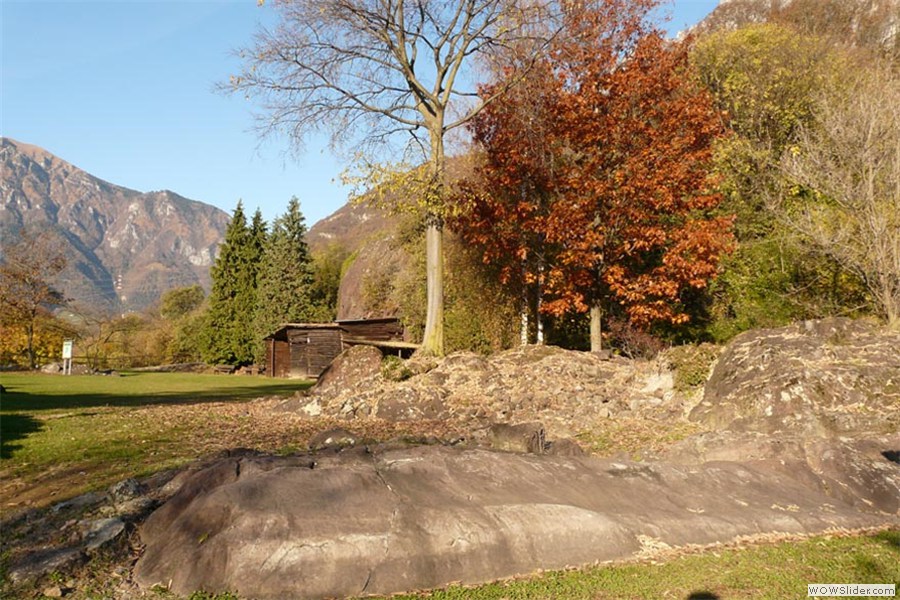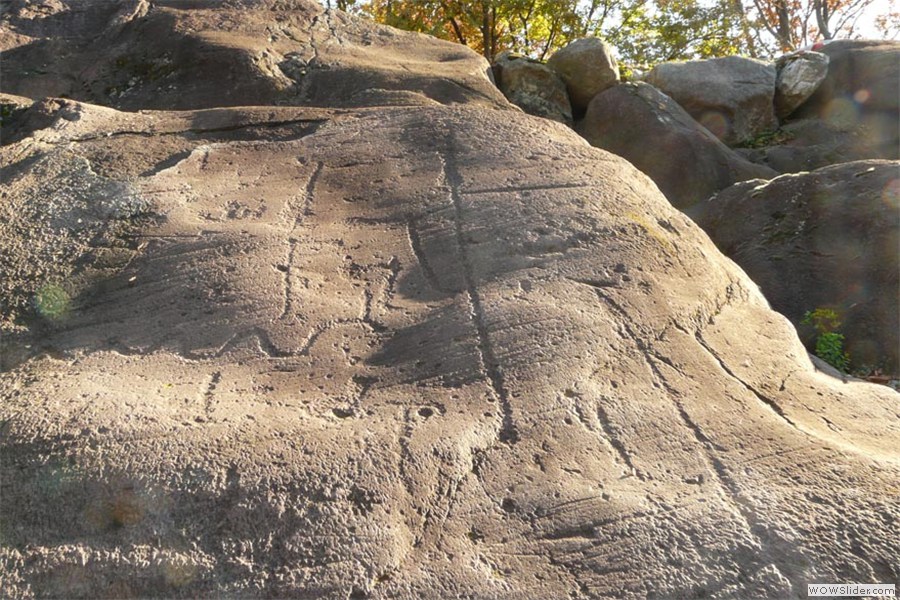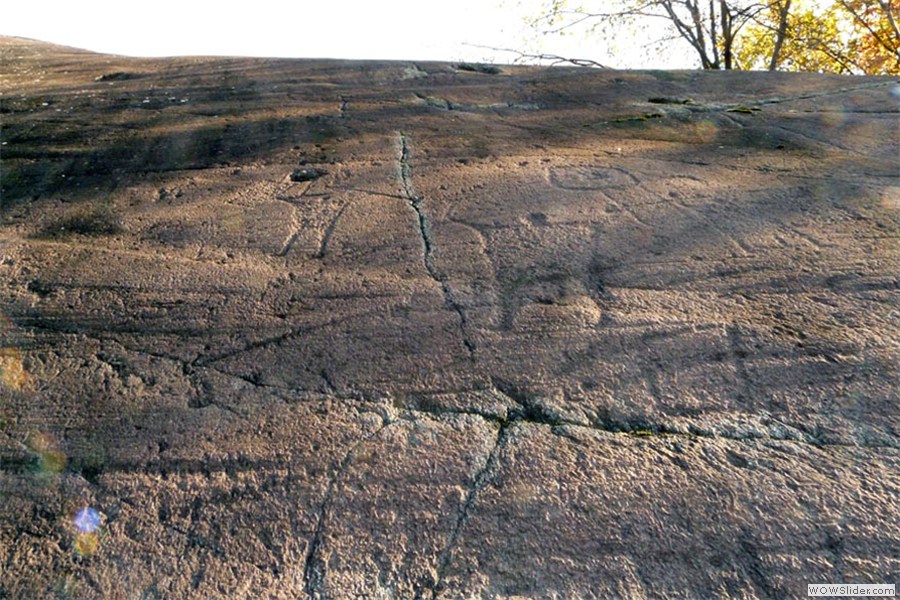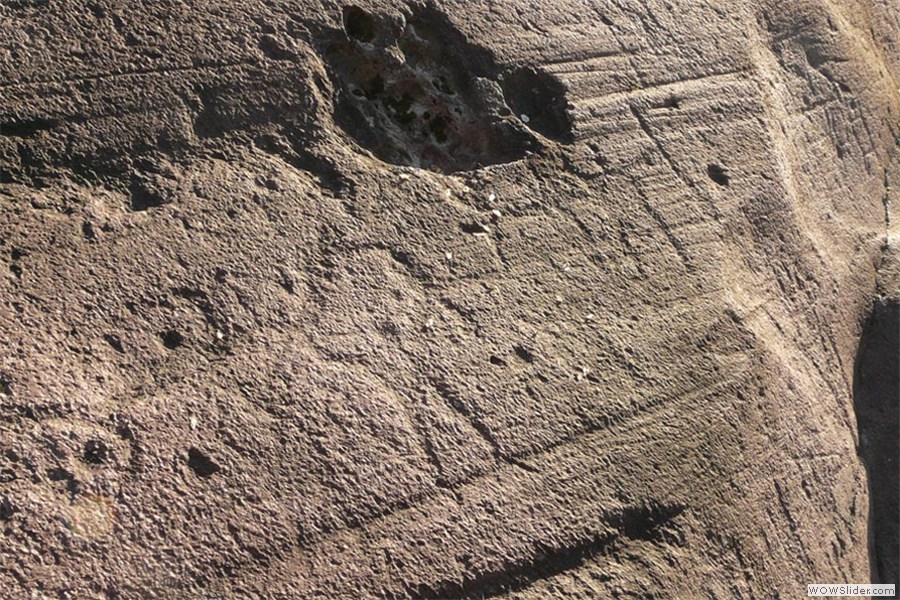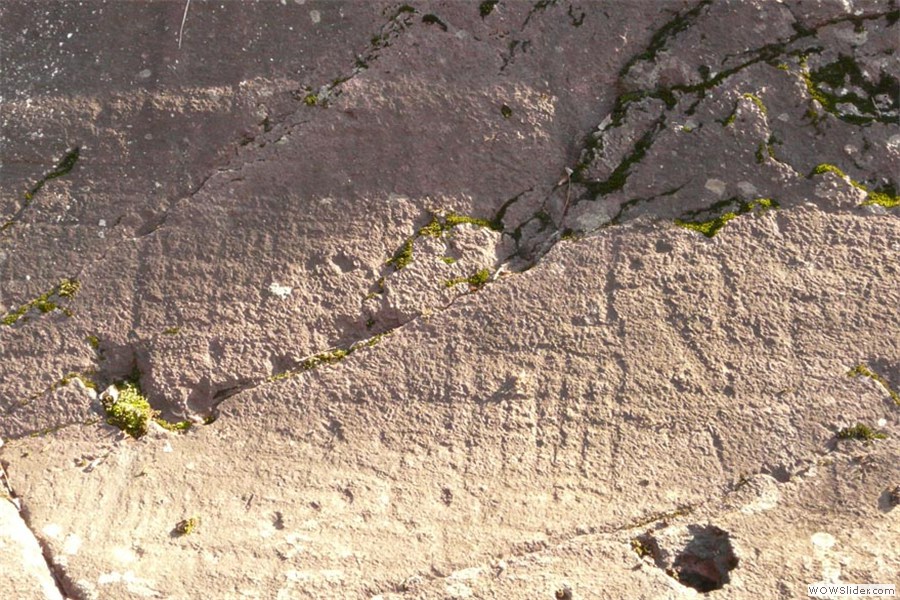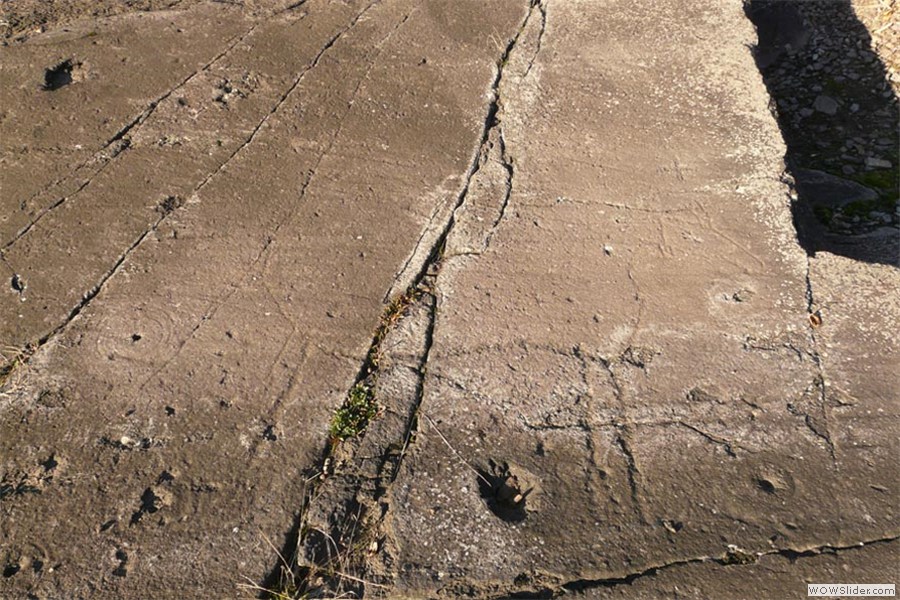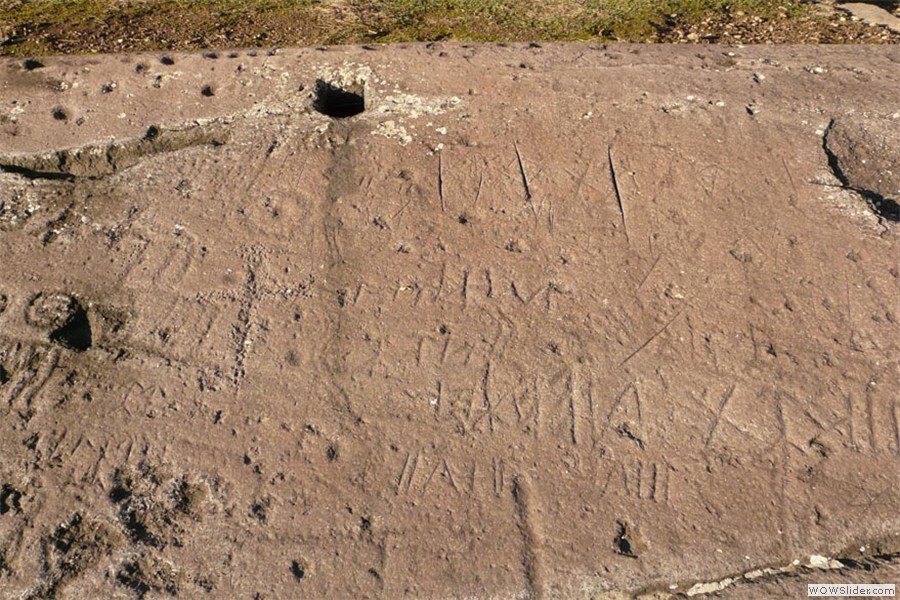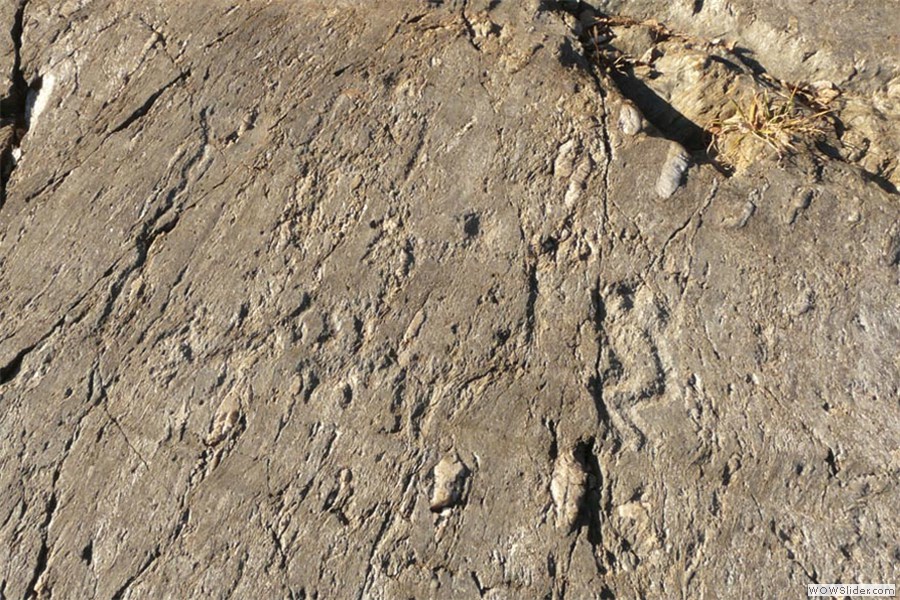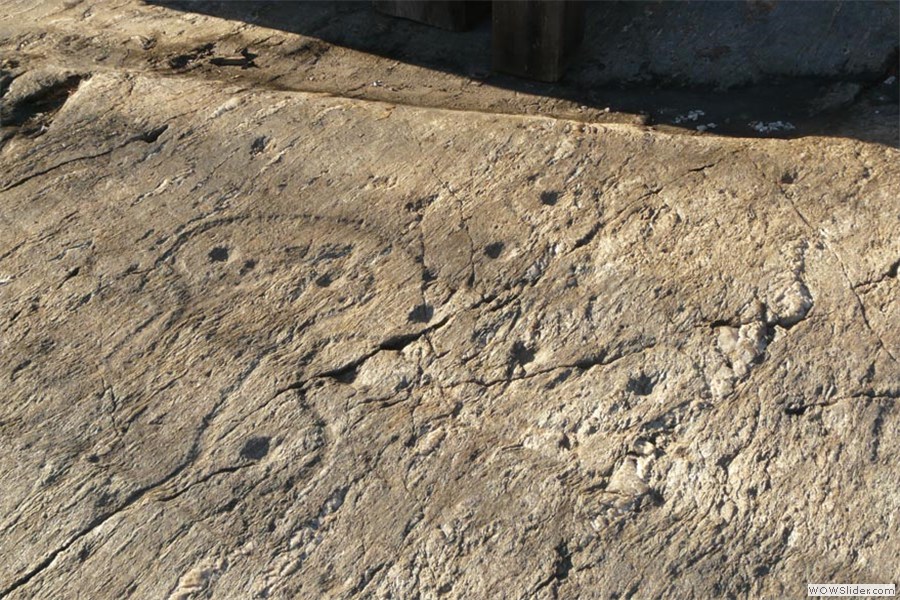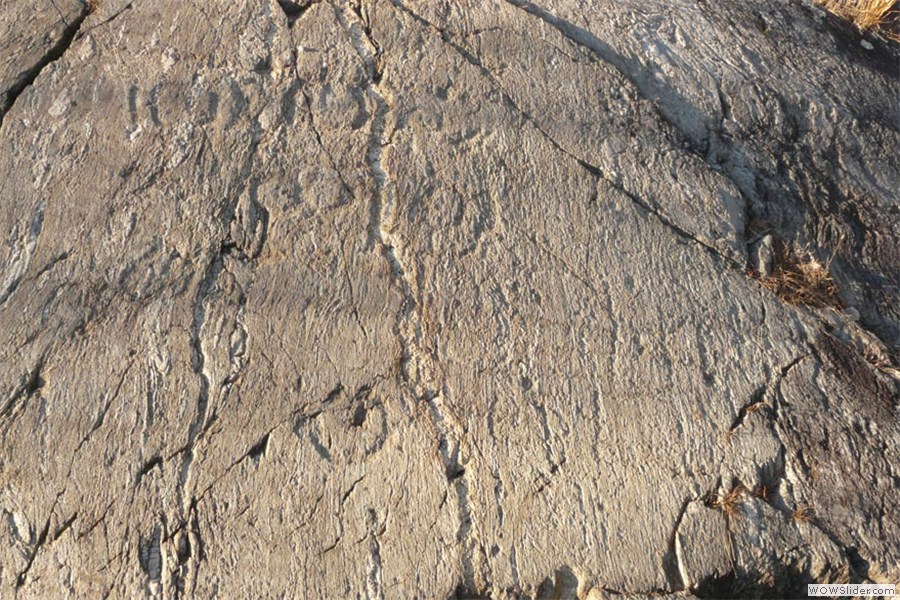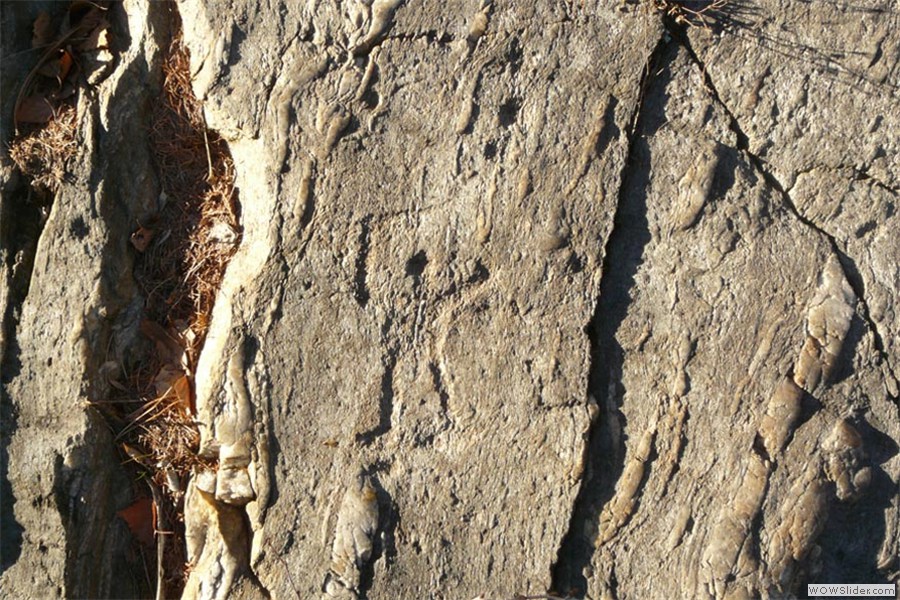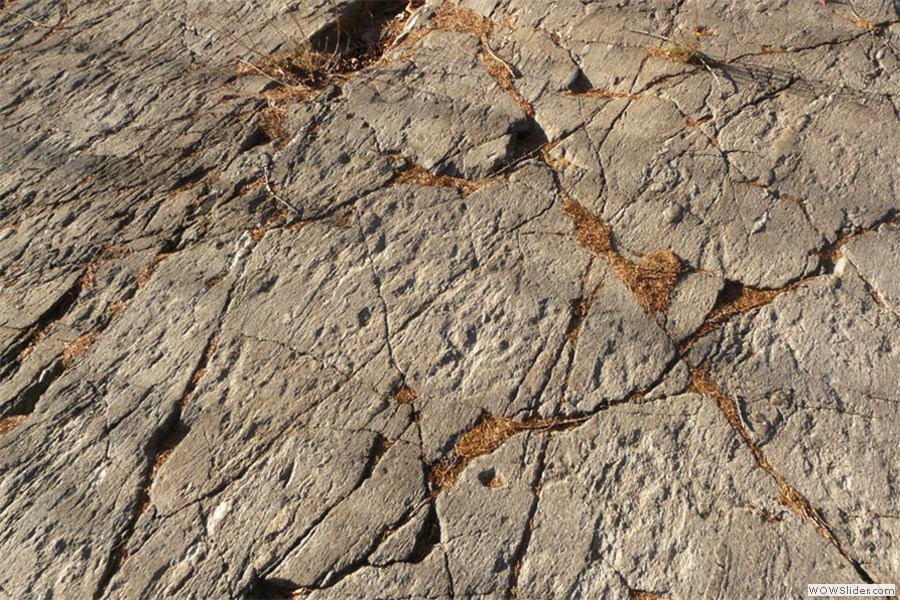Visit the figures! A single day gives a good glimpse. A full week is comprehensive and complements exploring the valley’s varied history, culture and landscape.
Valcamonica, narrow, steep-sided, well populated, and with much industry, lies north of the cities of Bergamo and Brescia, in Lombardy, northern Italy. At the valley’s lower, southern end is a handsome lake, Lago d’Iseo; at its higher, northern end are Alpine mountains, up to the Adamello at 3554 metres; the art is in a middle zone, on the lower slopes of the valley sides.
Researches carried up to nowadays in Valcamonica brought to light hundreds of thousands of images engraved on local smooth sandstones. In Valcamonica the habit of rock engraving began with the earliest rare expressions of the last Palaeolithic hunters (7th–5th Millennium BC) and went on without interruption passing through Prehistory and Proto–history, since Neolithic (5th–4th Millennium BC) up to reaching, with some gaps, even historical age (14th–16th centuries AD). The richest activity took place during the Iron Age and developed along with the best–known Italic cultures of 1st millennium BC, such as Etruscans, Celts, Veneti, and Raetians. With those peoples Valcamonica had regular contacts and mutual ideological influences, until all the Alpine tribes were finally absorbed into the Roman Empire during the 1st century BC.
Though all the rock art areas discovered up to now in Valcamonica should be actually considered World Heritage, the eight Parks cover the entire Valley and allow a complete view of the extension and variety of themes and periods offered by the engraving phenomenon at large. The suggested route for discovering rock carvings, being a single day or several days long, should include first of all a visit to the Middle Valley sites (the Capo di Ponte Park and the Natural Reserve of Ceto, Cimbergo, Paspardo), adding then the most important site in Low Valley (Luine) and, according to the interest degree and the available time, one by one the other described parks (Corni Freschi at Darfo B. T., Asinino–Anvòia at Ossimo, Sellero and Sonico).
Use the thorough and excellent guidebook, in English: Valcamonica rock art parks: guide to visiting routes, Edizioni del Centro, 2011
- CAPO DI PONTE
- RISERVA INCISIONI RUPESTRI
- LUINE
- OSSIMO
- SELLERO
- SONICO
The Capo di Ponte area includes more than 500 engraved rocks and covers alone almost a third of the rock art discovered up to now in Valcamonica. Some of them, supplied with visiting routes, are included inside the Naquane Rock Art National Park(eastern side), the Massi di Cemmo National Park (western side) and the Seradina–Bedolina Archaeological Park (western side). These three parks, which can be easily reached by walk from Capo di Ponte town, permit to experience some of the most famous rock engravings in the whole Valcamonica and can be visited, after checked each park opening hours, during a one–day visit.
NAQUANE ROCK ART NATIONAL PARK
The Rock Art National Park of Naquane, in the Municipality of Capo di Ponte (Brescia), was the first park to be established in Valcamonica in 1955. In the park it is possible to see 104 engraved rocks, scattered in a natural environment dominated by chestnut trees, firs, birches, hornbeams and crossed by important historic paths. The chronology of Naquane rock art must be placed between the Neolithic (5th–4th millennia BC) and the Iron Age (1st millennium BC), though it is possible to find also some more rare engravings dating back to the Historic Age (Roman, Middle Ages and Modern times). The most represented period, marked by very interesting carvings and a rich variety of themes, is the Iron Age, when the Valley was settled by the Camunni people and the rock art reached its expressive climax.
r.1 - Also known as the "Great Rock" for its considerable dimensions, it strikes the visitors for the imposing aspect of its surface smoothed and shaped by the glacier and for the extraordinary richness and variety of the carved figures (about a thousand). Among the most ancient petroglyphs five vertical looms, probably dating back between the end of the Bronze Age and the beginning of the Iron Age, stand out.
The almost only theme of the northern part of the large R. 1 is the deer hunting. The high number of hunting scenes marking the rock art suggests the hypothesis that hunting was an initiation trial, which must be passed by the young élite in order to enter adulthood.
r. 50 – The rock is carved with praying figures, warriors (some of them of large dimensions), buildings, footprints and pre–Roman inscriptions, sometimes arranged so that they constitute complex assemblages. The path goes down the stairs and passes several human beings engraved according to a schematic style characterized by the "praying" position: their arms are straight up, opposing legs and line-shaped body, with some varieties (inverted "U" or "V" shaped legs).
Among the most outstanding carvings there are the horsemen, involved both in fighting and in hunting.
Like other northern Italy peoples the Camunni, living in the Valley during the Iron Age, adapted the Etruscan alphabet to their language in order to acquire a writing system. On the rocks at Naquane there are about ten inscriptions.
r. 35- This rock is a good example of the common phenomenon which consisted in carving new petroglyphs on earlier ones, thus producing overlapping of images dating back to different periods. This is probably the origin of the so–called "village scene" (Iron Age), where some buildings engraved upon previous deer hunting scenes take the aspect of a sort of village with its activities.
Another very interesting figure carved with considerable skill is the so–called "running priest": the lively drawn male figure wears a head gear with back bent feathers, raises one of his arms while the other rest on his hip and his legs bent in a way that may suggest a running or a dance (Iron Age).
Two big engraved boulders and a prehistoric megalithic sanctuary. Remains include extraordinary monumental compositions dating back to Copper Age and surrounding stone structures. Good visibility. Bottom of the valley environment.![]()
SERADINA-BEDOLINA ACHAEOLOGICAL PARK
The Seradina–Bedolina Archaeological Park includes the two contiguous areas rich in rock art of Seradina and Bedolina.
The lower site of Seradina — divided in the sub–areas of Seradina I, II and III — is marked by the wide spread presence of armed human beings and especially by the unusual frequency of subjects which are rare in other parts Valley, such as the ploughing scenes (Seradina I–Corno), the building figures and the pre–Roman inscriptions (Seradina II). The rocks, usually small in size except for the large n. 12 in Seradina I and a few others, show warriors, animals and several unidentified signs.
At Bedolina, on the plateau above Seradina, many rocks carved with "topographic compositions", such as the well-known "Rock of the Map", have been discovered.
Seradina I, r. 12 – The wide surface is one of the most important and best–known in the whole Valcamonica rock art and is marked by a combination of themes which makes it unique in the context of the local Iron Age.
This rock seems to draw the inspiration from the classical themes of an hypothetical Valcamonica élite class of warrior–chiefs: ploughing scenes connected to erotic ones, hunters and dogs chasing goats, horsemen hunting "solar" deer, fighting scenes with attendants, tiny bird figures, etc.
Bedolina r. 1 - The Bedolina area is no doubt marked by the wide spread "topographic" compositions, whose best known example is right on R. 1 — the so-called "Bedolina Map". It consists of particularly convoluted figures, generally composed by rectangles or squares filled with precise rows of cup–marks and linked together by lines so that they form extended and highly interconnected "super–figures".
Such engravings were produced in slightly simpler types as early as the Ancient Copper Age (or even probably during the Late Neolithic) and were carved in expanded and much complex form during the Iron Age.In addition to the geometric composition R. 1 is carved as well with some sporadic armed human being, a few animals and some building representations on its lowest part, but especially with the only Camunian rose to be found on the more than 160 engraved rocks included in the Park.
The meaning of the Camunian rose is still hidden and mysterious.![]()
The Rock Art Natural Reserve of Ceto, Cimbergo, Paspardo covers a more than 300 hectares large area and is placed in a unique archaeological, environmental and ethnographic setting. The archaeological sites within the Reserve include about 500 rocks carved in prehistoric times and in the Middle Ages, all placed on the eastern side of Middle Valcamonica. Such a rich set of rock art is uniformly distributed, sometimes in thick groups, all the mountain side long, beginning in Foppe di Nadro area (Ceto), then going up to Campanine di Cimbergo and continuing beyond the Ré stream gorge into the Paspardo territory.
From Nadro, one enters an old cobbled path which is bordered by high walls with areas either side that have been cultivated for centuries. A little further on, at 500m a.s.l., the engravings begin: following these engraved rocks one comes to a vertical cliff under which have been found prehistoric shelters. From this point a marked path takes to Figna and then Campanine.
The engraved zone of Foppe is limited to a section of the mountain slope, displaying a high density of thickly decorated rocks. The engravings date back from the V millennium BC to the upper Middle Ages. Of particular importance are the figures from the Bronze Age (II millennium BC with a rich typology of weapons) and the phase of Etruscan influence.
Just before the engraved area is a small plateau where an Iron Age village has been reconstructed (from tested and documented basis or archaeological evidence): a granary with hayloft, a hut of Rhaetian type, surrounded by cultivated flats with typical growth of the firs millennium BC. Principal engraved rocks you can view on the itinerary r. 1, 6, 4, 22-23, 24, 26-27
r.1 - The engraved part can be divided into three chronological phases: the sector below presents engravings from the Neolithic Age (IV millennium BC) with 'orants' (derived from the Italian, orante (sing.), oranti (pl.): humans standing with arms raised as if in prayer or adoration). The part above was engraved in the second half of the last millennium BC and includes figures with weapons and duelling warriors, whilst on either side are medieval crosses.
r.6 - This rock was engraved almost entirely within a recorded time-span, from the VIII to the V centuries BC, which is the so-called 'phase of Etruscan influence' from the obvious influx of this civilisation. Numerous iconographic themes are repeated: footprints (around 200), five-pointed stars, and dwelling structures. In the lower part of the rock it is possible to observe an extraordinary group of dynamic and refined fighting figures and, on top of them, five–pointed stars and two inscriptions in pre–Roman local alphabet. Four of the five men fight in couple, two in a duel with weapons and the other two in a sort of boxing fight which has some similar examples in the Raetian and Venetic Situla Art (the remaining fifth figure on the left may be part of another unfinished analogous couple). Such activities, which may be defined as a "ritual sport", are not uncommon in the Italic world of Early and Middle Iron Age, as they were usually performed during the funerary rites of the community élite members.
r.4 - The rock is marked by a definite prevalence of weapons engravings related to Copper Age and early Bronze Age. This quite uncommon concentration of such a specific subject may represent a symbolic echo (virtual deposition?) of the coeval phenomenon of the metal hoards and votive offerings on mountain top and into water.
r.22 - 23 - This vast and elongated surface presents four engraved areas: in the upper part possible ritual dance scenes from the late Neolithic, whilst the areas in the centre and to the right are incised with a rich typology of early Bronze Age weapons, and a late Chalcolithic component with ploughing scenes and daggers.
r.24 – On the upper part quickly comes in sight the scenic representation of several building figures (the so–called "village") while two warriors dancing around a Camunian rose stand out on the lowest part. The high concentration of huts, among which there are footprints and inscriptions, occupies a considerable part of the surface and it is composed of more than thirty structures seemingly built on poles, carved in different sizes and typologies and datable to various Iron Age phases. Down the walkboard human beings images are dominant, mainly with weapons but seldom fighting and often incomplete. Two "dancing" figures armed with radiant round helmets, swords and small shields, apparently in relation with a four–petal Camunian rose from which an arrow leaves, clearly stand out among the crowd of human beings. Another similar warrior with round helmet and long dress likely dances opposite an extraordinary and quite unique flute player. Though less visible and mixed with pecking marks it is possible to catch a sight of several finely scratched figures, among which many noteworthy inscriptions and two daggers in anchor–shaped ending sheat (the so–called "Introbio-Lovere" type) engraved in life–size and certainly dating back to the latest phases of Valcamonica rock art ( 2nd century BC– 1st century AD).
r.26-27 - The rocky outcrop named R. 27–26 represents one of the greatest rock art concentrations in the region and is one of the largest engraved rocks in whole Valcamonica. The western part of it, next to the walkboard, is marked by several petroglyphs dating back to the middle and late Iron Age. Among these pictures there are many armed figures and fighting warriors, dogs, deer, the so–called "Nadro temple" (a complex building with several related symbols), concentric circles, shovels, footprints and other geometric signs. The great image of a horse, horseman and squire is especially noteworthy and gives evidence of the extraordinary importance attributed to the horse as a status symbol during the Iron Age. On the southern section of the surface, which appears finely smoothed by the glacier action and slightly sloping, some remarkable scenes can be observed: the so-called "butterfly idle", the scene of so–called "dog worship" (a praying figure associated with several dog images), some armed praying figures, footprints, concentric circles, cup–marks and an interesting Solomon knot made in scratching technique.![]()
Campanine is a vast area, central to the Reserve, characterised by natural 'steps' and high rocky cliffs, alternating with small 'plateaus', which over millennia were the sites of small villages with enclosures (the area of Figna), that are now abandoned.
Ongoing archaeological research has individuated around 100 engraved rocks, of which only around 10 are included in this itinerary.
The area began to be engraved in the late Neolithic period (end of the IV millennium BC), though the practice was then temporarily abandoned over the following centuries (there are extremely few engravings from the III and II millenniums BC), before beginning again in the last millennium BC. Recently, a rich and at present unique concentration of post-Camunian engravings have been identified, extending from the end of the Roman era and throughout the medieval period.
Principal engraved rocks you can visit on the itinerary: about 10 minutes from the entrance point beside the road are the first rocks on view: r.1, 5-6-7, 8
r.1 - Large surface with a rare figure of labyrinth type "Cretan", with seven unintended and unique path from the outside towards the center. The labyrinth evokes a complex path that transforms one who does it and thus be linked to rites of passage (birth, puberty, marriage, death).
r.5-6-7 - The rock outcrop, in the past partially covered with soil and vegetation, includes with no interruption R. 5, 6 and 7. R. 7 is the large top surface and shows praying figures, sometimes in vertical or horizontal combination, some building figures, warriors and quadrangular–shaped axes dating back to the Middle Iron Age. On an isolated part of the rock, some metres to the north, there is one of the largest building representations (more the 1 m high) of the whole Valcamonica rock art, while on the upper part it is possible to observe a very rich panel of historic times (13th–14th centuries), carved with more than forty images of keys, crosses and other Christian symbols.
R. 5 is characterized too by the presence of prehistoric figures together with historic ones. Among the former the most striking ones are: the images of buildings (about twenty–five), a deer hunting scene (quite rare in Campanine), the several warriors. In the central and lower sections of the rock, highly complicated because of the superimposition tangle, it is possible to distinguish three inscriptions in local pre-Roman alphabet and a Latin inscription ("JOVIS"), perhaps a dedication, superimposed by Christian crosses. It is also worth mentioning, on the right side of the lower section, the representation of a human being holding three keys (perhaps Saint Peter or Saint Roch), which may be obviously linked to the Christian iconography spread throughout the whole area.
On the contiguous R. 6 the first engravings to be noted are several crosses and two extraordinary dates (1319 and 1330) written in Latin numbers (that is "бCCCIX" and "бCCCXXX". However the most striking rock art here is composed by the great number of scratched images, among which several gallows (in one case with the condemned person hanged by one foot), Solomon knots, inscriptions, stairs–shaped figures, five–pointed stars, crossbows, some large heraldic symbols (such as the crowned eagle, symbol of the powerful local Federici family), couples of dices (perhaps a metaphor of the Passion of the Christ), a priest on his knees with a mitre covering his head, a human figure holding a sickle (the Death?), an image of a tuber and other schematic signs of difficult identification.
r.8 - Along the western border of the small plateau below R. 8 rises. It consists of a not extended rock surface well–known since the '50s for its two ploughing scenes. This scene, up to now unique in Valcamonica repertoire, may be dated back among the most ancient discovered (beginning of the Copper Age, between about 3300 and 2800 BC) due to the seemingly archaic depicting style and the structure of the plough.![]()
In this area a number of engraved zones of middle or small size are all located in an impressive, mainly pristine mountain environment.
In Val
Access: from Paspardo (playground area). An extremely suggestive area, with wide panoramas over the Valley, numerous outcropping rocks, some of which are engraved.
Of particular importance: r.4/ The engraved part contains some 500 figures concentrated in 2 longitudinal sections. Most of the figures are from the Iron Age (I millennium BC). From the upper left: scene with animals, large warriors with weapons of the La Tène type, and some minor combat scenes. In the lower section, a series of schematic 'orants' probably from the late Neolithic.
Plas / Capitello dei 2 Pini
Access: from Paspardo, heading north on an ancient, marked pathway.
This area began to be engraved in the III millennium BC; here are those elements that are referable to the phase of monumental compositions. In the upper part is the well-known composition of the Five Daggers, with the object symbols of this phase arranged in recurrent succession (horns-sun, daggers, parallel lines); in the lower part there are three clusters of engravings from the same period (III millennium BC): on the left leafed axes with animal and pendants, next to a composition of concentric circles with parallel lines, stick-figure anthropomorphs. All of these compositions are similar to the statue-stelae from Lombardia and Trentino.
Sottolaiolo
Access: along the new Deria road, five minutes from Paspardo.
At the beginning of the road to Deria (about 800m from the town) one meets this small engraved area: 6 engraved rocks make up the itinerary, most of which engraved in the Iron Age. THIS ITINERARY IS EQUIPPED FOR PERSONS WITH IMPAIRED SIGHT AND PHYSICAL DISABILITY.
r.1/ Warriors, axes and cupmarks alternate on this rock, on the right are some 'rose camune'.
r.2/ On this flat rock we find engraved figures of warriors and 'shovels' all dating from the last millennium BC.
r.4/ On this rock (from which one can see most of the Valley) are duelling figures, 'shovels' and other symbols all attributable to the Iron Age.
Vite / Deria – 'al de Plaha
Access: along the Deria road
Following the road to Deria spot the marked visiting area called 'al de Plaha with important topographic compositions and clusters attributable have been found which are datable to the late Neolithic and early Bronze Age. The area is still undergoing research. ![]()
The Lago Moro Park covers a large area within Darfo–Boario Terme and Angolo Terme territories. Currently included sites (only in part contiguous) are five: Luine, Monticolo, Castellino, Sorline, Conca del Lago Mor.
The findings brought to light on the hill suggests a long and continuous use of the top area by one or more prehistoric tribes who for thousands years turned it into their territorial reference for rituals and cultural identity. Indeed, in addition to the more than 100 carved rocks which constitute the main archaeological finding of the Park, some other remains have been found, such as likely cult sites, hut bases and dry wall structures, which prove the essential importance of this place for the whole Low Valcamonica territory. It was perhaps a kind of "sanctuary" recognized by several nearby settled tribes who met here for ceremonial and collective activities.
The hill environment is still nowadays harsh and uneven and is home to the most ancient archaeological evidences in Valcamonica prove the presence of hunting tribes as early as 15.000 BC. The big animals (such as elk and deer) engraved at Luine, still visible on two of the surfaces arranged along the visiting route, are probably to be related to these first human groups. Thanks to the comparison with other European rock art sites today we can date these pictures back to the 8th–7th millennia BC and they are likely the most ancient evidences of the human presence on the hill.
During the following millennia it seems that the area was temporarily abandoned and was again used as a favourite carving place at the end of the Neolithic (4th millennium BC), the Copper Age (3rd millennium BC), the Bronze Age (2nd millennium BC) and finally the Iron Age (1st millennium BC). These returns of people to the same old place after thousands of years may suggest the hypothesis that Luine was considered as a sort of "sacred hill" by local tribes. Principal engraved rocks you can view on the itinerary: r. 34, 57, 6
r. 34 - The "queen" rock of Luine is no doubt the following R. 34, a very large bedrock whose mass completely dominates the southern side of the area. The image richness of R. 34 allows to embrace with a single glance the entire Valcamonica rock art cycle — from the archaic age of epi–Palaeolithic animals to the final phase of the Iron Age — and thus it is able to show more than 8.000 years of human history!
In the upper part some big figures of armed men can be distinguished at first sight. Below the warriors section there are grid–shaped figures, rectangles and lines running along the surface for several metres. The left side of the rock is covered with some enigmatic maze–shaped forms and with a remarkable representation of a Cretan labyrinth (carved up side down, the entrance being above). The right part of R. 34 is carved with a Bronze Age composition formed by an ordered series of spears, long–blade axes with enlarged edge, some halberds, a dagger (or perhaps a short sword), rectangles and snake–shaped figures, a pattern wide–spread during the Early Bronze Age (about 2200–1800 BC).
The upper part of R. 34 can be observed from the path running along it to the east. In this section a special attention should be paid to the important image dated back by Emmanuel Anati to the Proto–Camunian period (before the 7th millennium BC). It is a deer image being probably hit by some throwing weapons (arrows? spears?) and whose head is turned back. The large dimensions (about one metre long) and the posture of the body may suggest an epi–Palaeolithic hunters graphic tradition, seemingly on the basis that the ancient carver focused only on the "wounded" animal and completely skipped any reference to the hunter. On the same portion of the rock several carvings of Bronze Age weapons and rectangles with rich inner decorations can be seen.
r. 57 - is a large sloping bedrock, almost completely covered with inner–decorated rectangles. According to Anati this theme appeared as part of an ideology established after the Copper Age frequentation of the hill (3rd millennium BC). The rock also shows several axes (on the right and left side), which in some cases are placed around "facce–oculi" compositions likely resembling human shapes.
r. 6 – This rock is covered for more than 50 square metres with petroglyphs, but unfortunately their preservation status is not always good.
The upper part of the bedrock is marked by a rich concentration of inscriptions in local pre–Roman alphabet.
Finally on the central and left side of the rock it is possible to see, partially hidden beneath the Iron Age inscriptions, the engravings usually considered as the most ancient in the long Valcamonica rock art tradition. It is a group of animals carved in the so-called "sub–naturalistic" style, marked by the simple outline of the body and dated back by Anati to the Proto-Camunian Age, therefore before the 6th millennium BC. All around them there are several engraved rings, simple or with a cup–mark in the centre. Many of these circle figures were indeed created by a peculiar compass scratching technique quite common among all the other Valcamonica rock art areas. ![]()
At the foot of the Monticolo hill a ceremonial site probably dating back to the Late Copper Age (end of the 3rd millennium) has been recently brought to light. The archaeological area core is a large carved boulder which in prehistoric times was included in a fascinating environment setting and which has been recently excavated by Lombardy Archaeological Office in the occasion of restoration (2002-2003) and touristic enhancement (2008) works.![]()
The Ossimo–Borno plateau includes some of the most important sites of Valcamonica Prehistory and more generally of the whole Alpine area. They are the so–called "ceremonial sites" or "megalithic sanctuaries" and date back to the Copper Age (3rd millennium BC), a time when the erection of big stones, often decorated, and the remains of ritual activities give evidence of the presence of cults lasting sometimes for millennia.
The Anvòia archaeological area let the public enjoy a large complex of kindred sites probably mutually linked in a sort of "landscape system". They are primarily marked by rows of standing stones erected during the Copper Age (3rd millennium BC) and by several artificial elements placed in order to give a ceremonial aspect to a part of the mountain slope.
r. 2-3 - is an imposing outcrop deeply shaped by the action of the glacier. A long walkboard allow the vision o many petroglyphs without damaging the rock surface.
The very first phase of rock art production may well be identified in the only female praying figure and, especially, in the geometric composition — rectangles, circles and lines — on the eastern end of the outcrop.
The only certain point is that a clear renewal of the engraving activity can be observed only after the Middle and Late Iron Age (7th–1st centuries BC). The main feature of the rock in this period is the carving of unusually big figures: a gigantic human being holding an axe and a kind of basket, commonly called "The Wayfarer" and explained as a possible representation of the Celtic god Esus (3r–1st centuries BC); a big warrior holding a bent–bladed sword and a concave shield surrounded by smaller armed figures; a swastika–shaped and geometrically perfect Camunian rose, which is the largest example of its kind in the whole Valcamonica (one metre long).
Near the panel carved with Camunian roses — in addition to the large swastika one there are two smaller four–petals roses — there is a fighting scene with two large warriors equipped with different weapons. The fighters are engraved with a quite rough and very deep pecking and an unusual big size in respect of the previous figures.
The area is the second one known in Valcamonica — the other being Sellero — where the petroglyphs are carved on mica schist rock (Edolo schist), rougher and more difficult to be engraved than the typical Middle Valley sandstone. This treat is particularly important because it seems to reinforce the hypotesis that the presence of particularly smooth bedrocks — common especially around Capo di Ponte and Darfo B.T.— does not represent a binding element for producing rock art.
Furthermore at Sonico there is a range of engraved subjects well selected: geometric figures (different types of circles, cup–marks, geometric compositions, lines, etc.), some peculiar symbolic figures (the so–called "shovels"), a few unarmed human figures and animals.
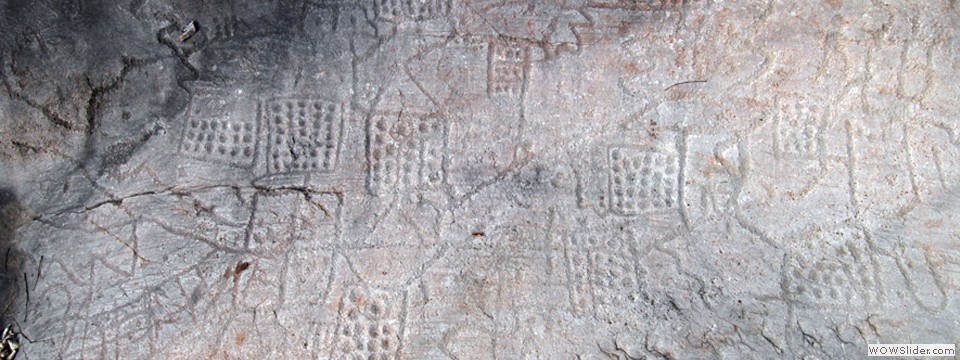
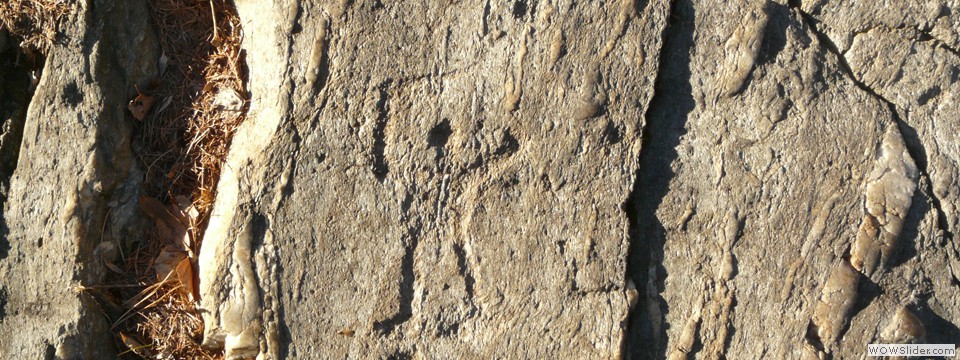
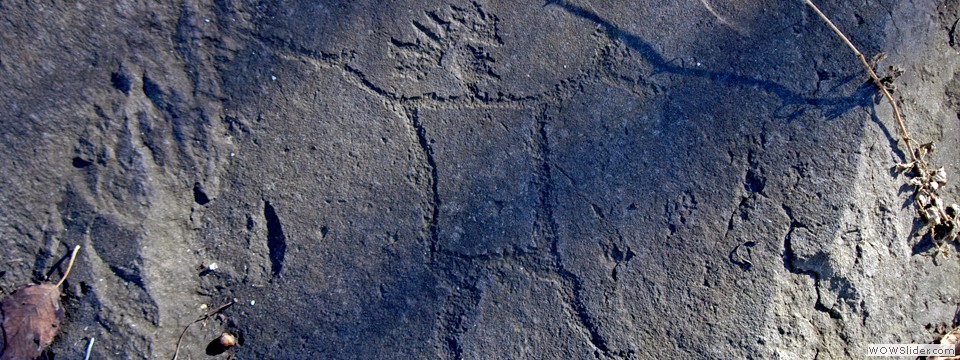
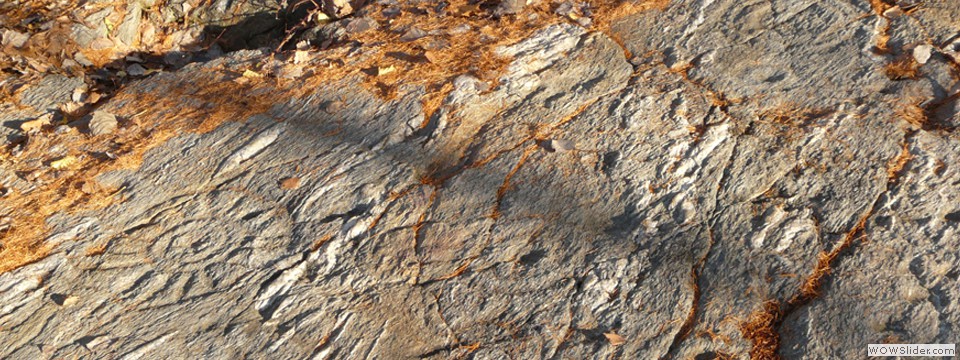
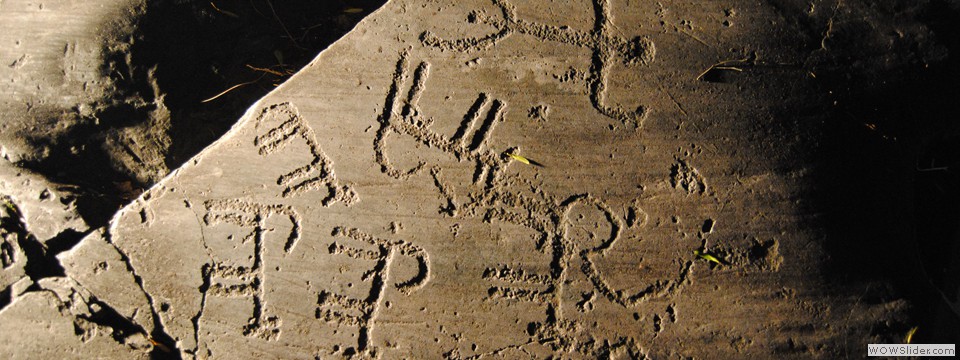
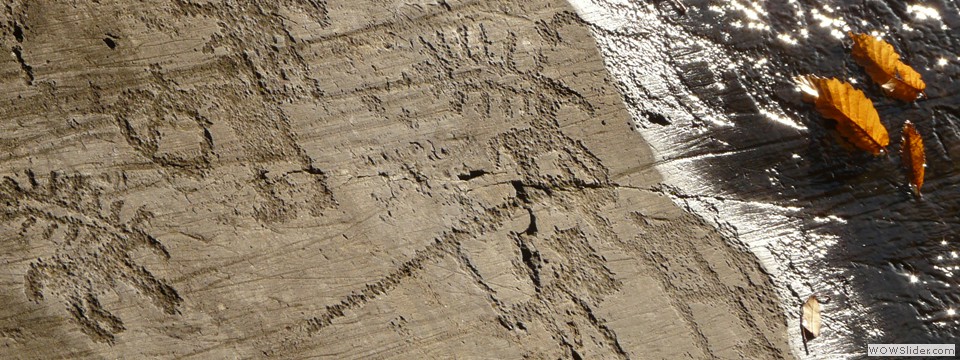
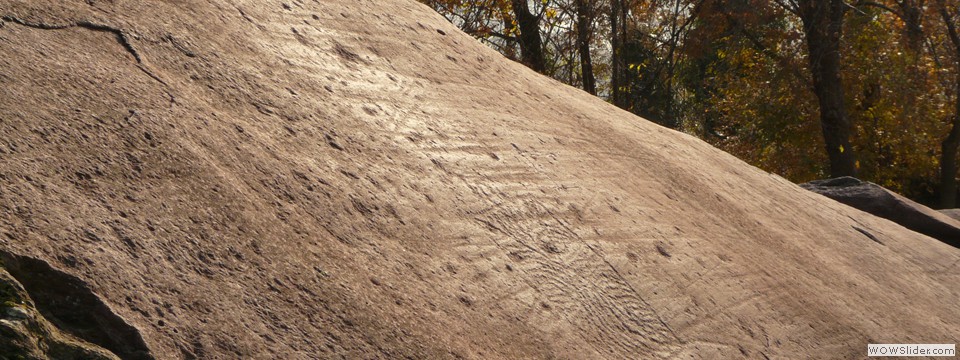
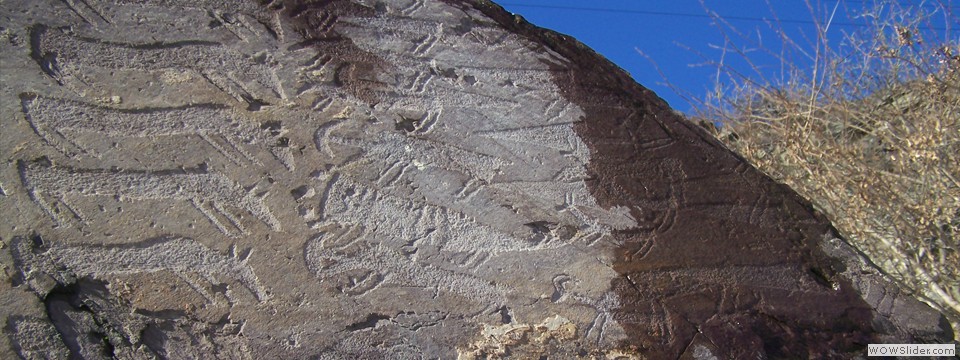
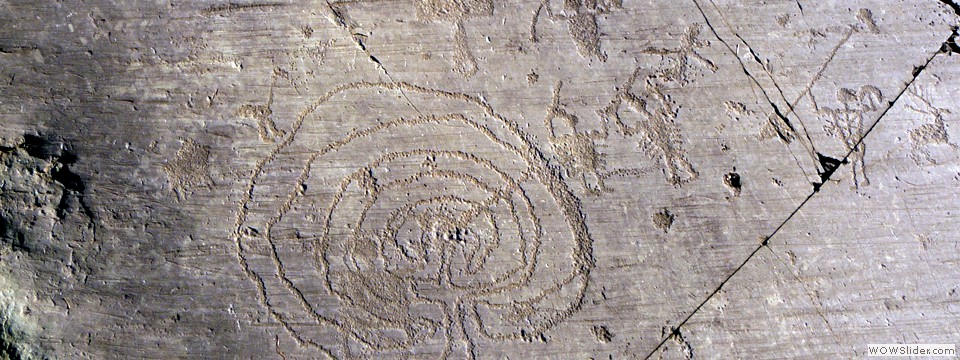
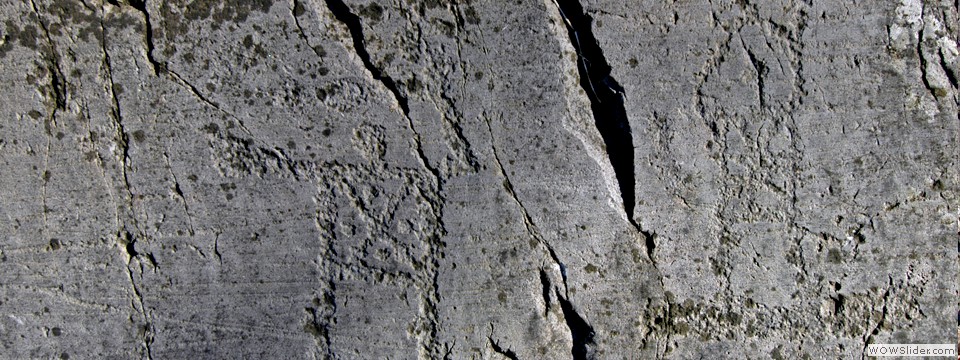
 1
1 2
2 3
3 4
4 5
5 6
6 7
7 8
8 9
9 10
10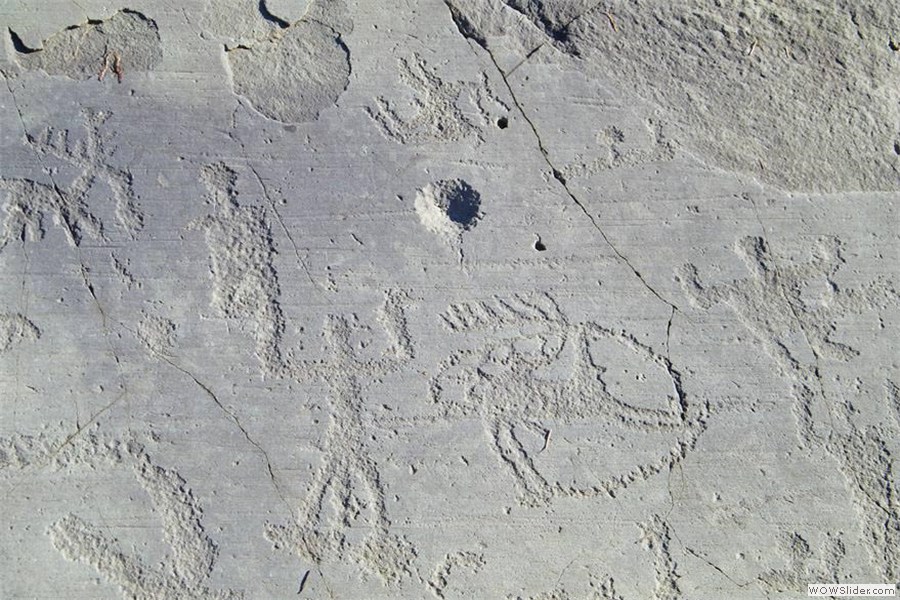
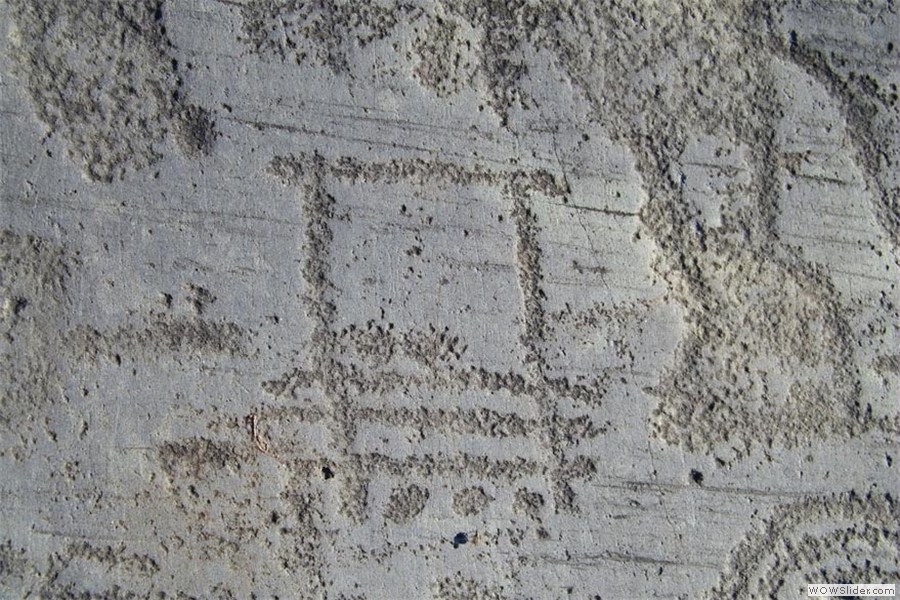
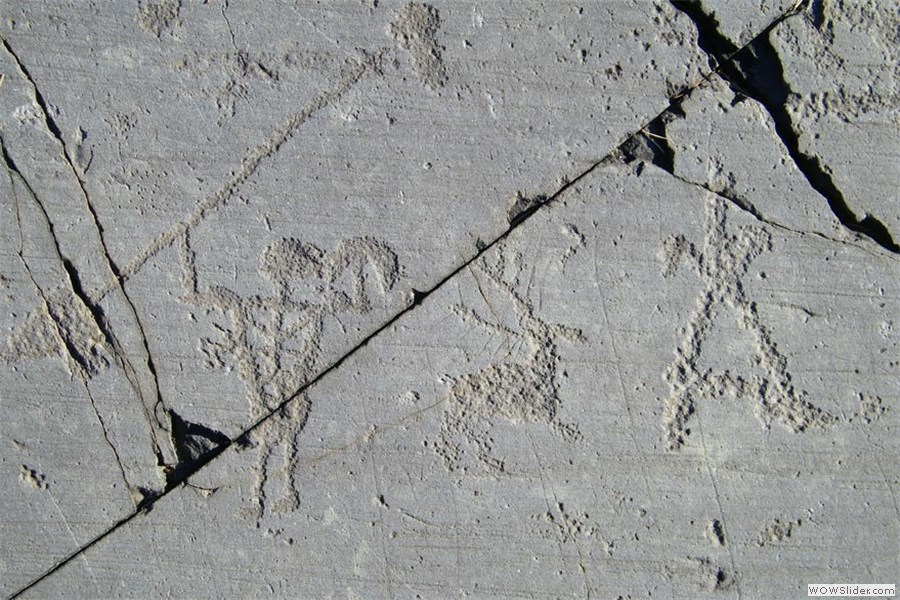
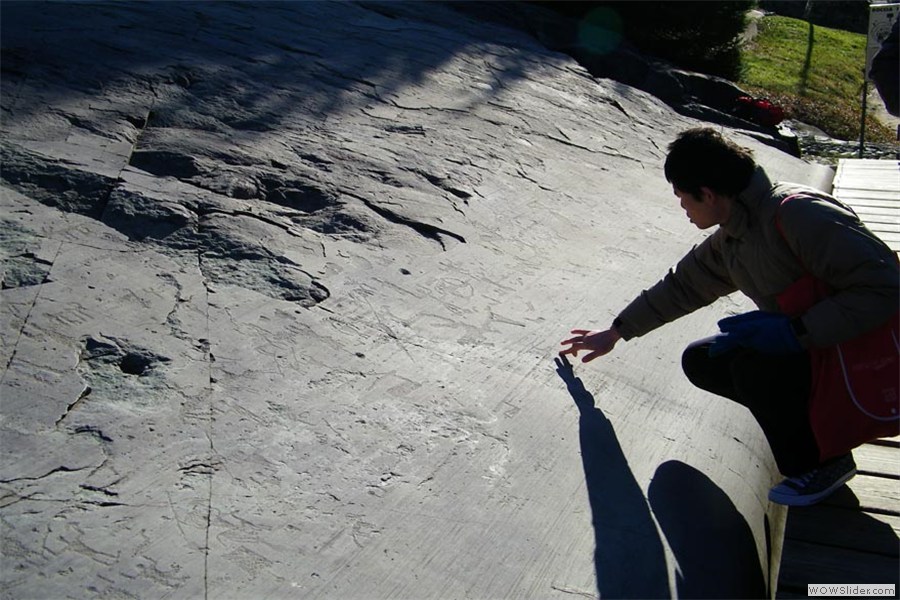
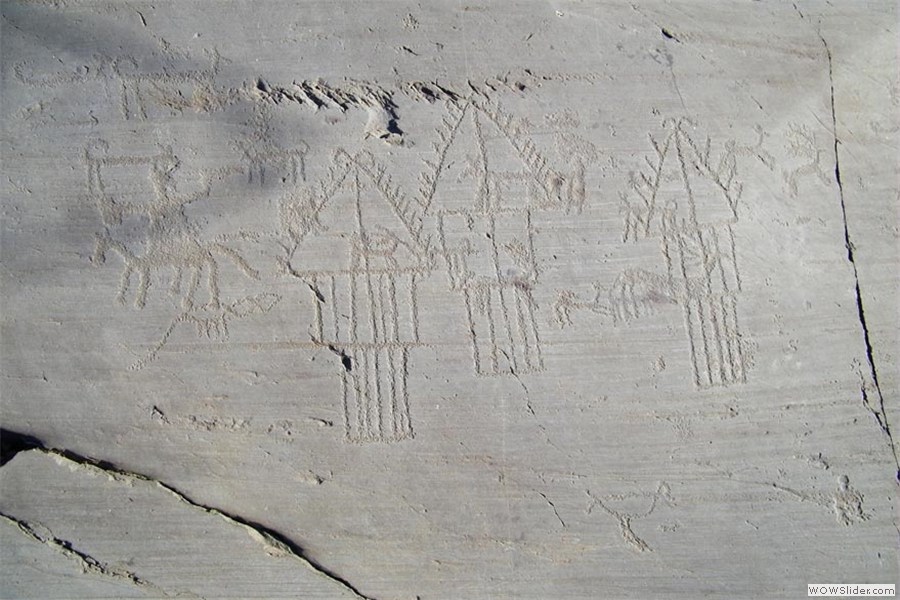
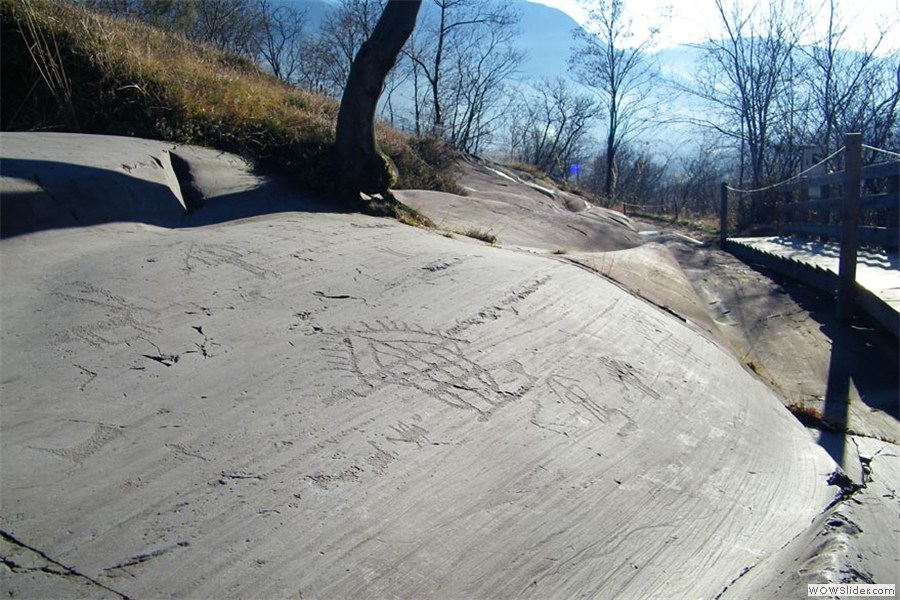
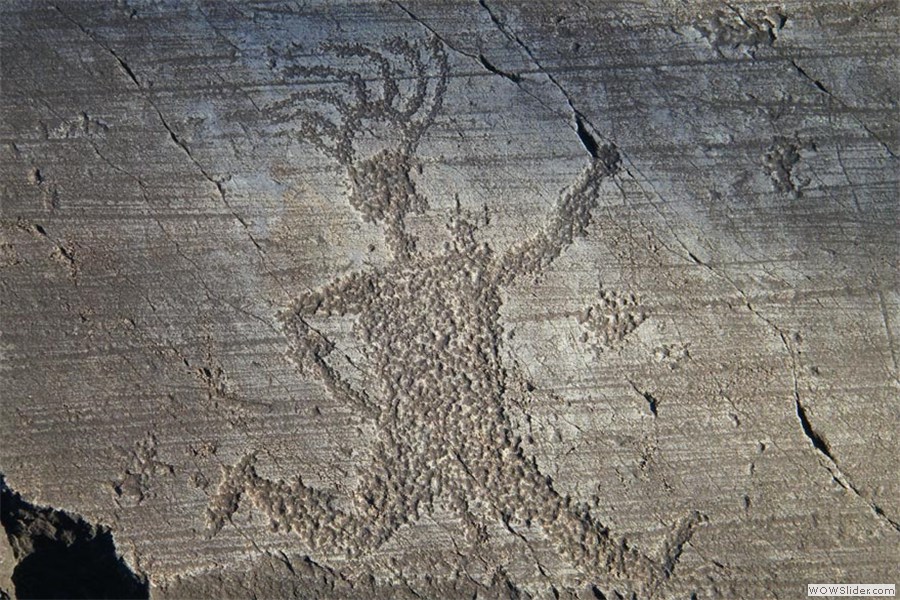
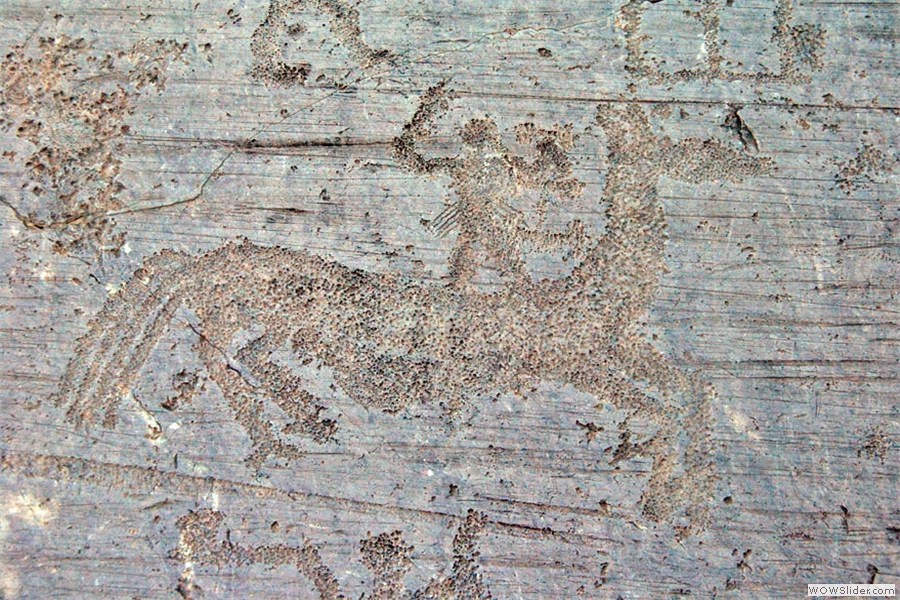
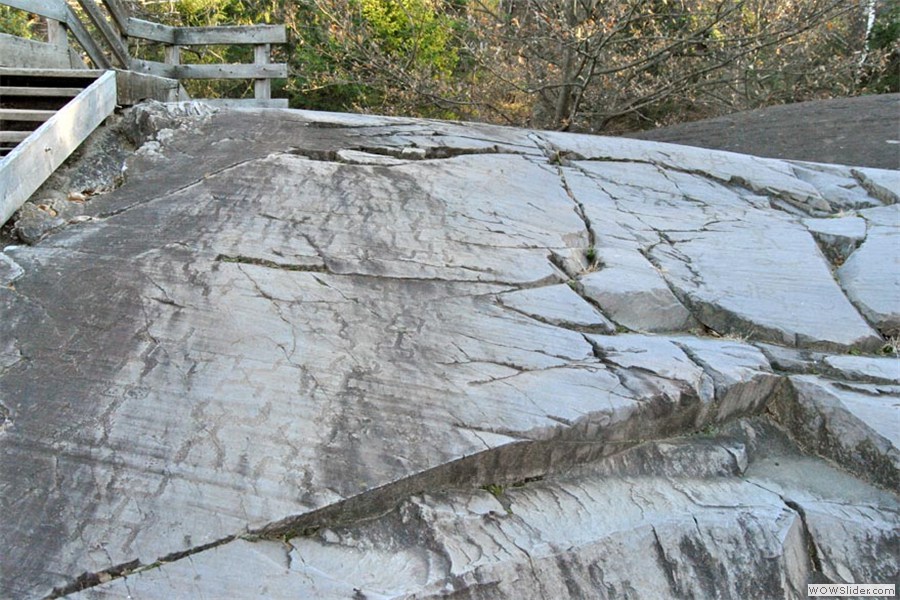









 foto G.R.
foto G.R. foto G.R.
foto G.R. foto G.R.
foto G.R. foto G.R.
foto G.R.



 foto A.M.
foto A.M. foto A.M.
foto A.M. foto A.M.
foto A.M. foto A.M.
foto A.M. foto A.M.
foto A.M.




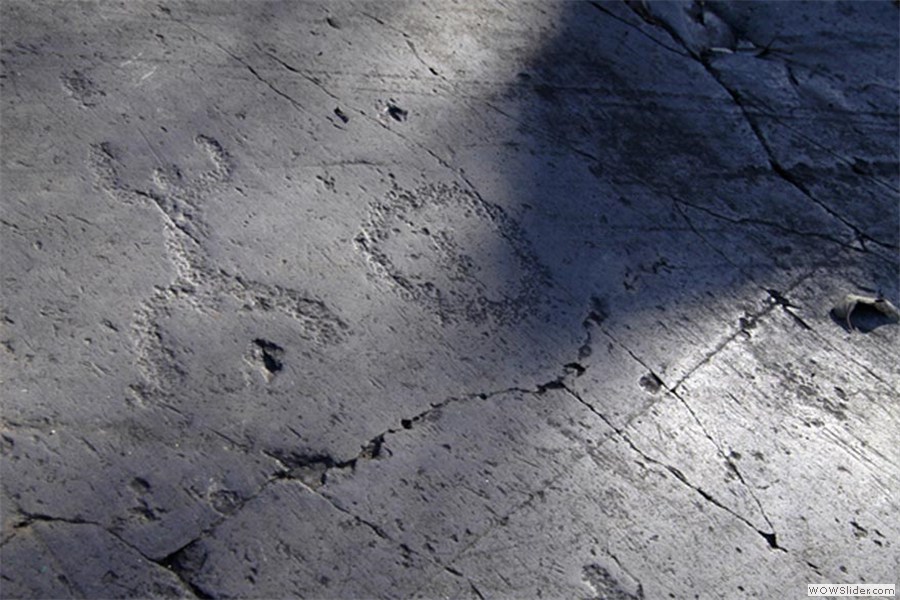 foto A.M.
foto A.M.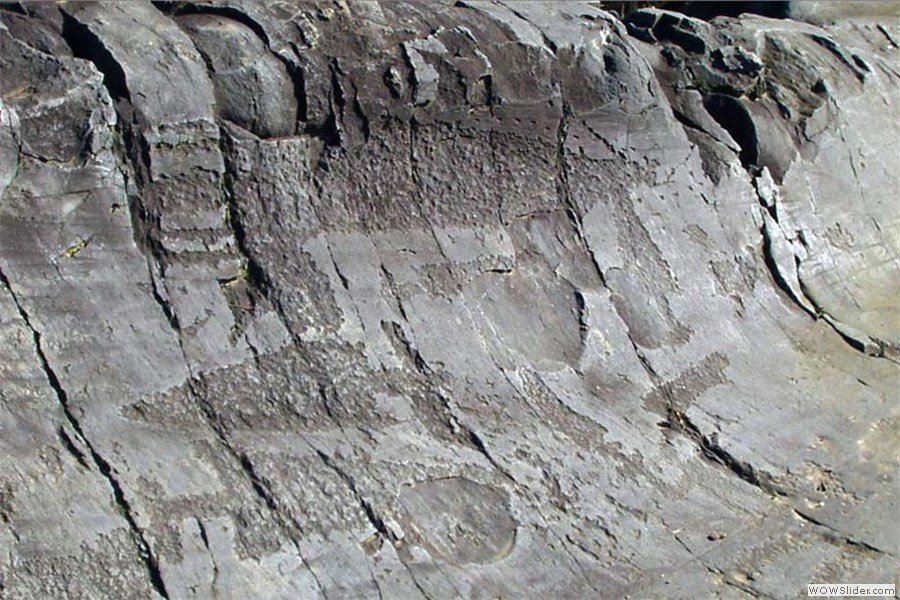 foto A.M.
foto A.M.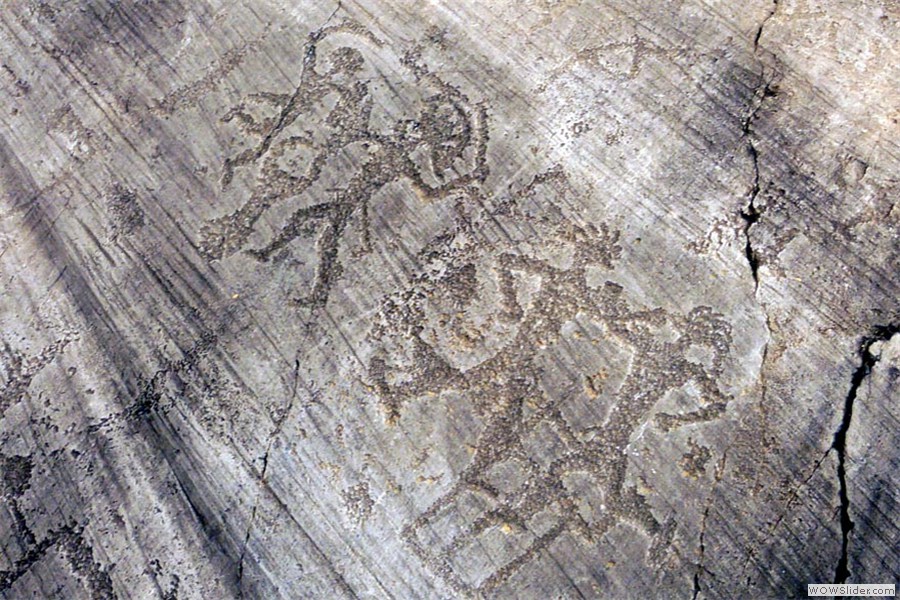 foto A.M.
foto A.M.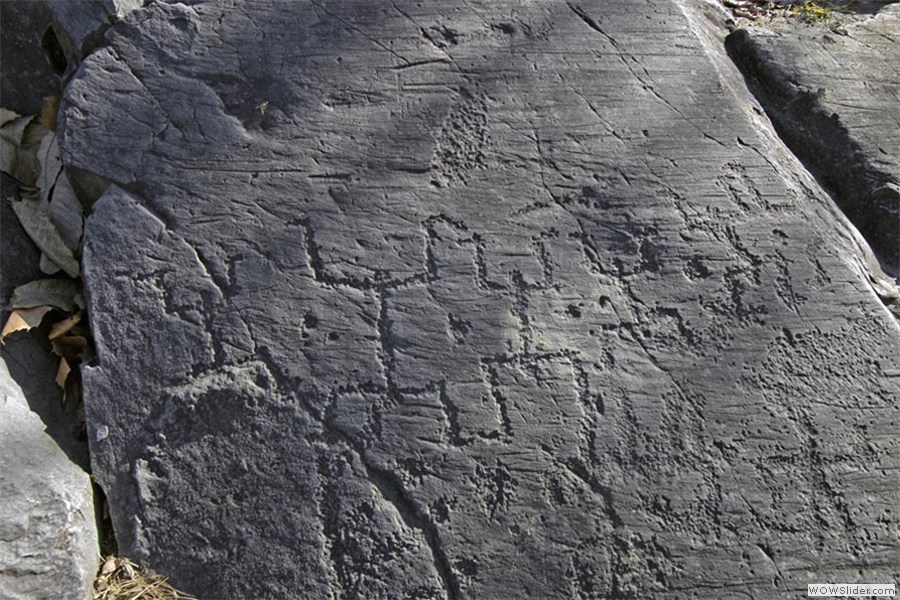 foto A.M.
foto A.M.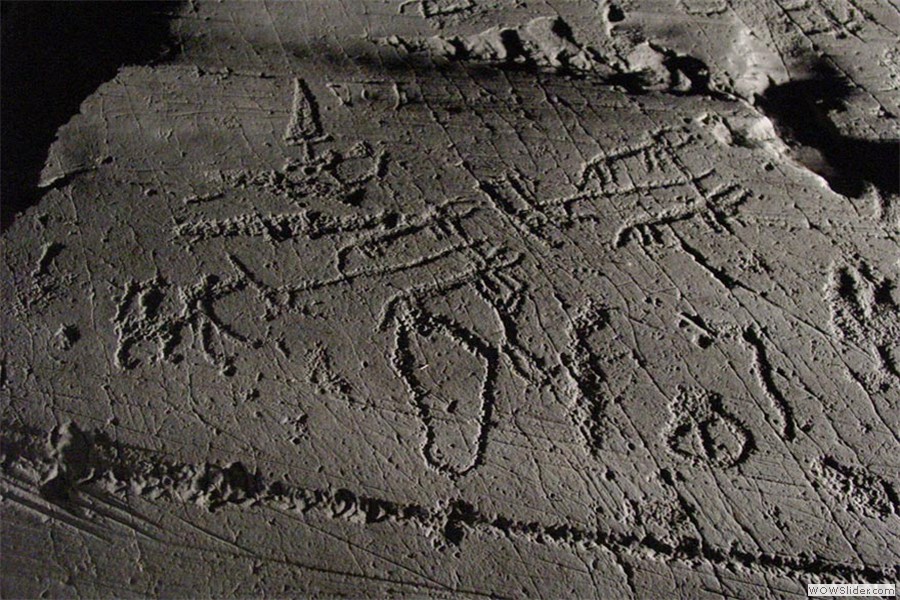 foto C.G.
foto C.G.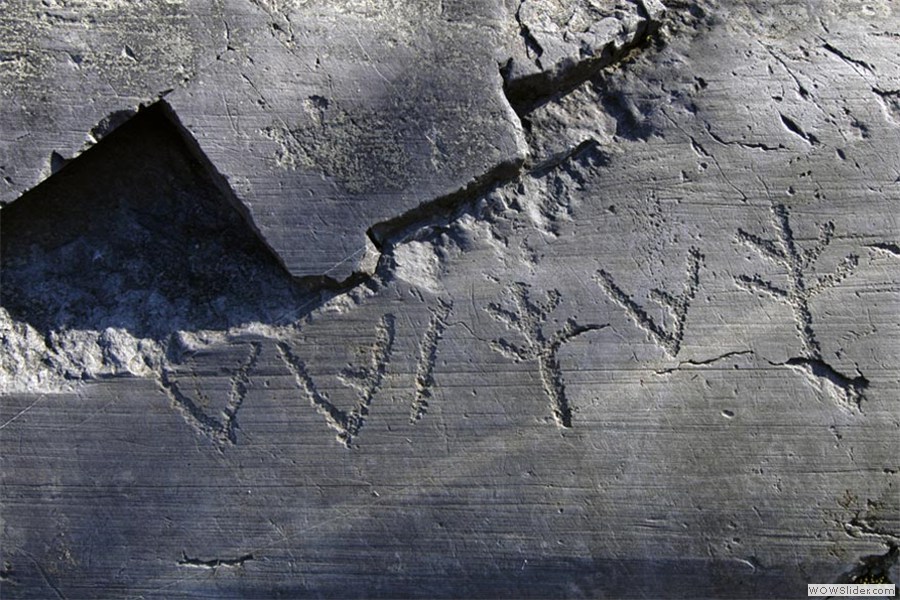 foto A.M.
foto A.M.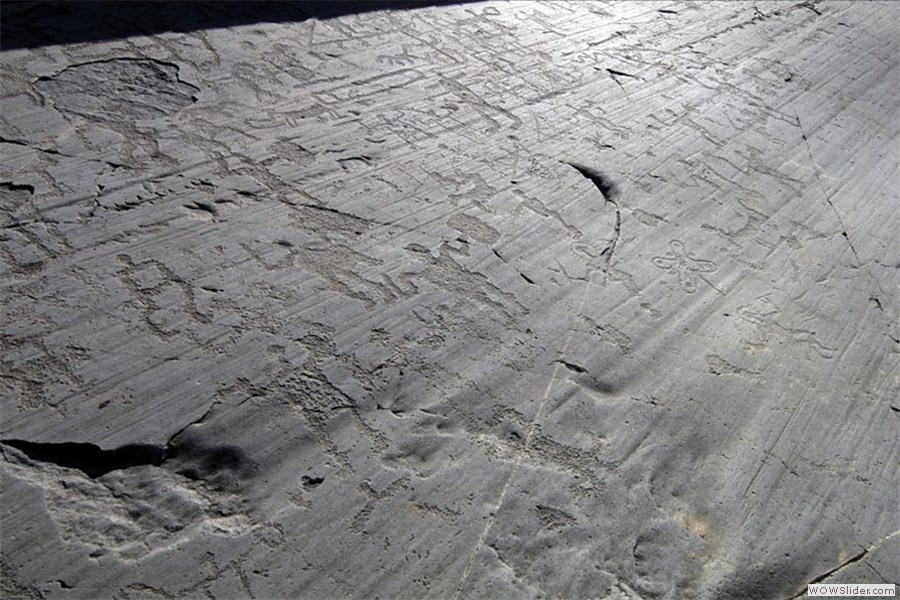
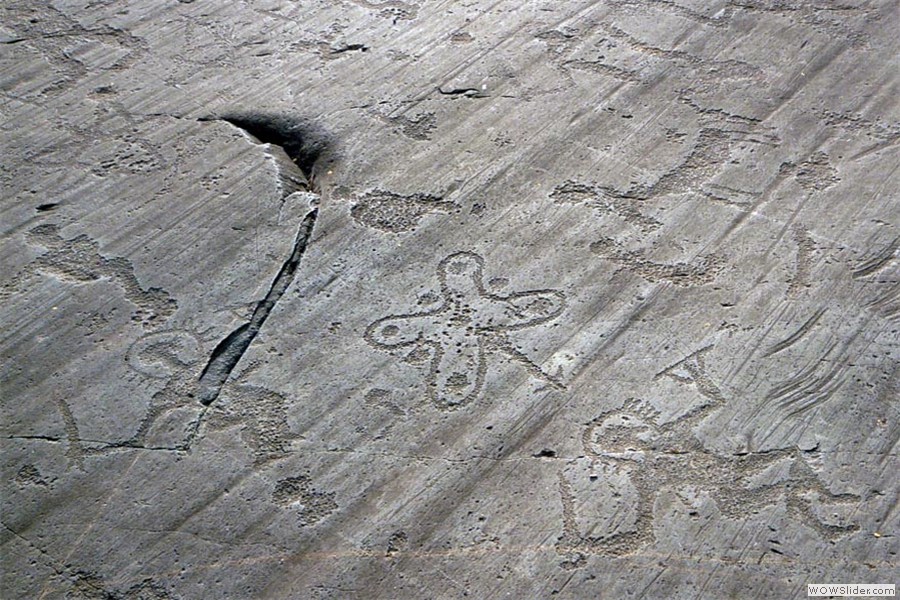
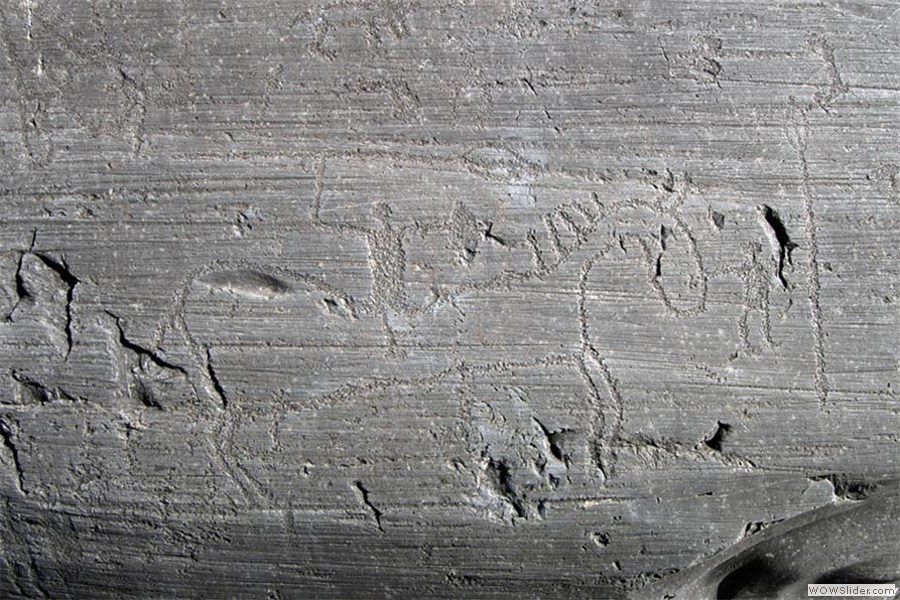









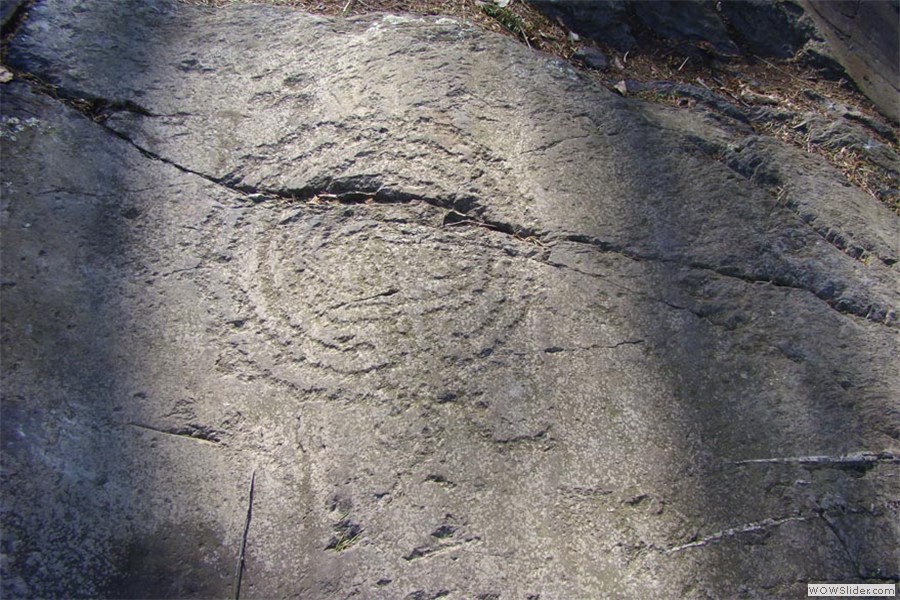 foto M.C.
foto M.C.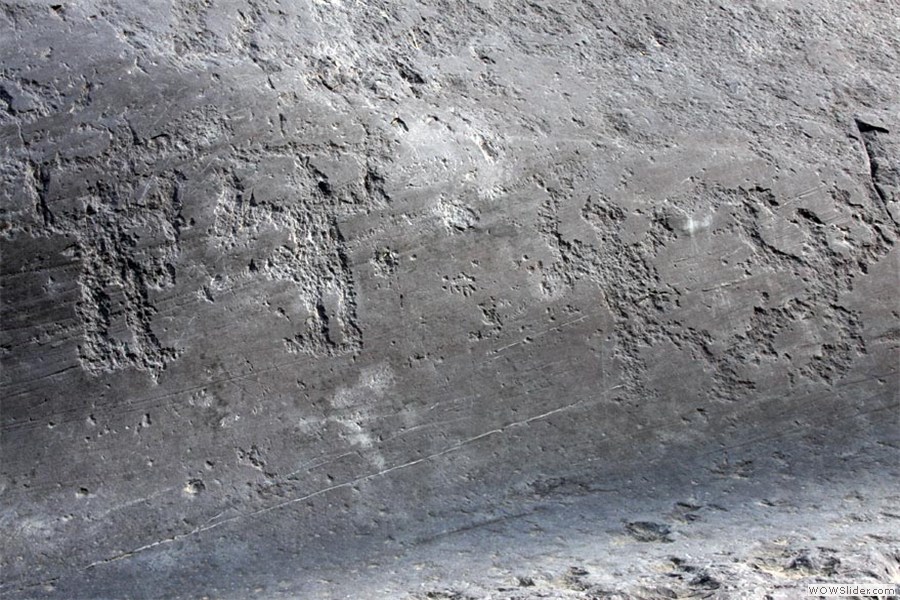 foto M.C.
foto M.C.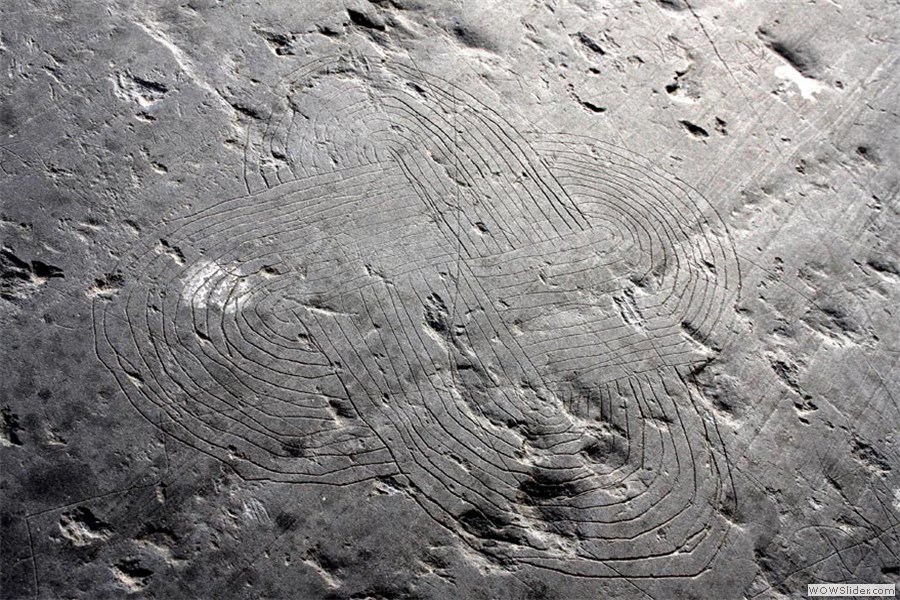 foto M.C.
foto M.C.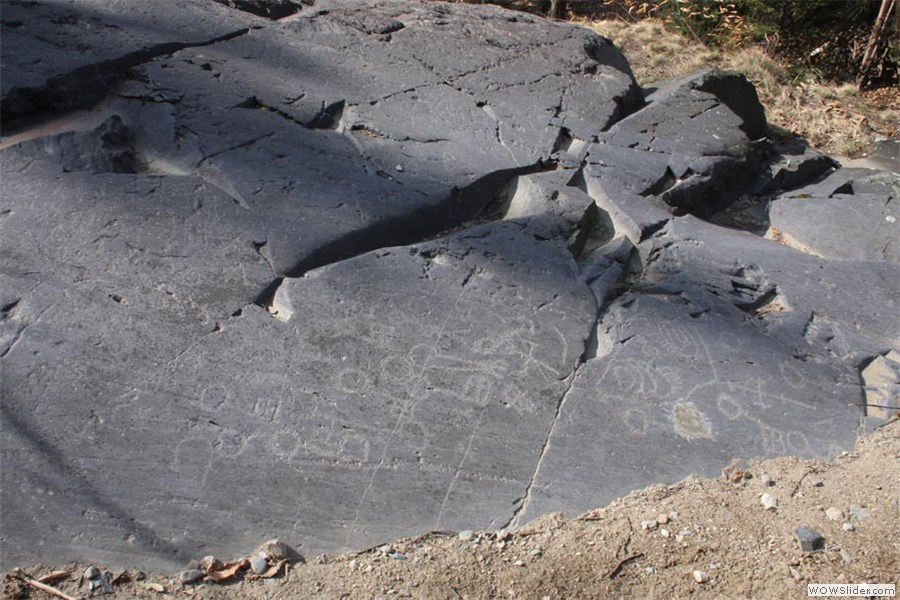
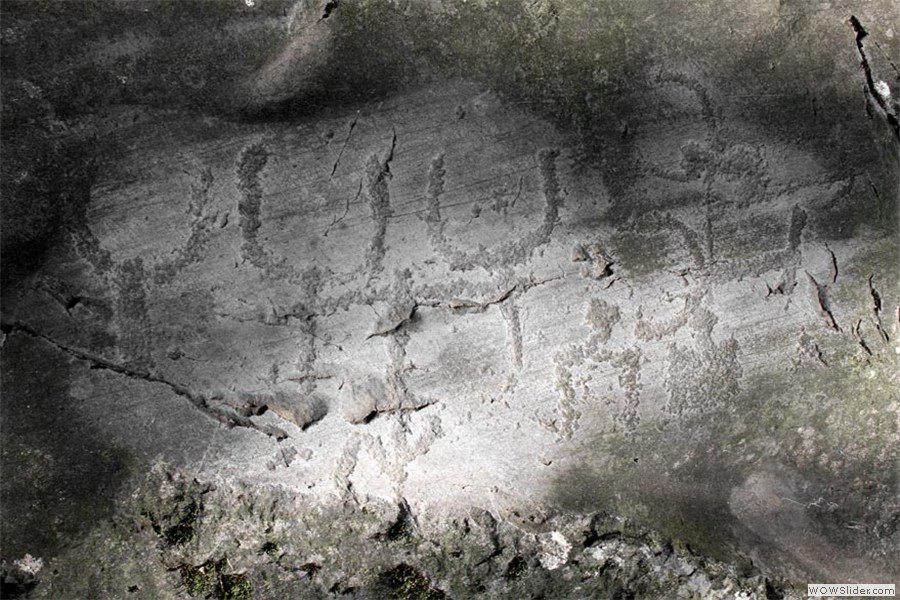 foto M.C.
foto M.C.




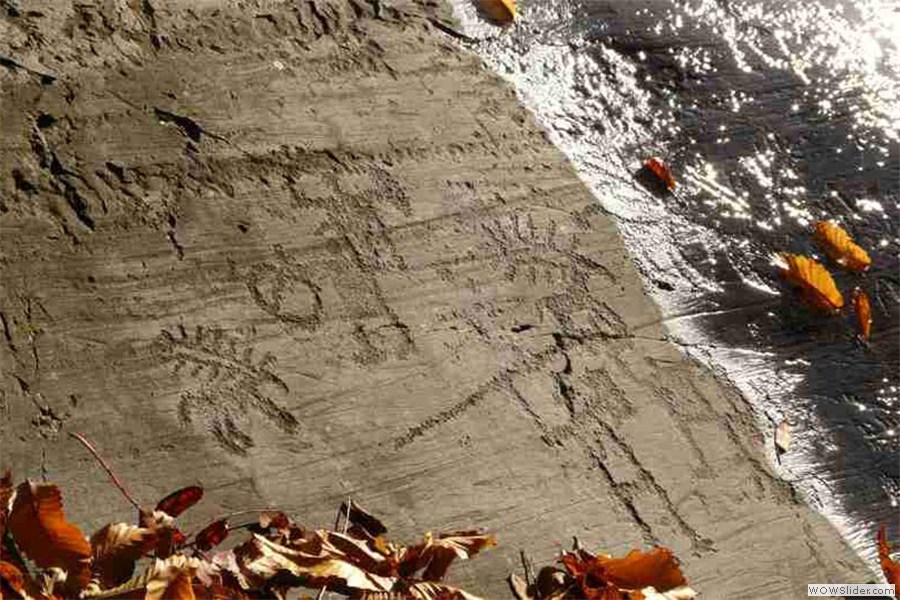
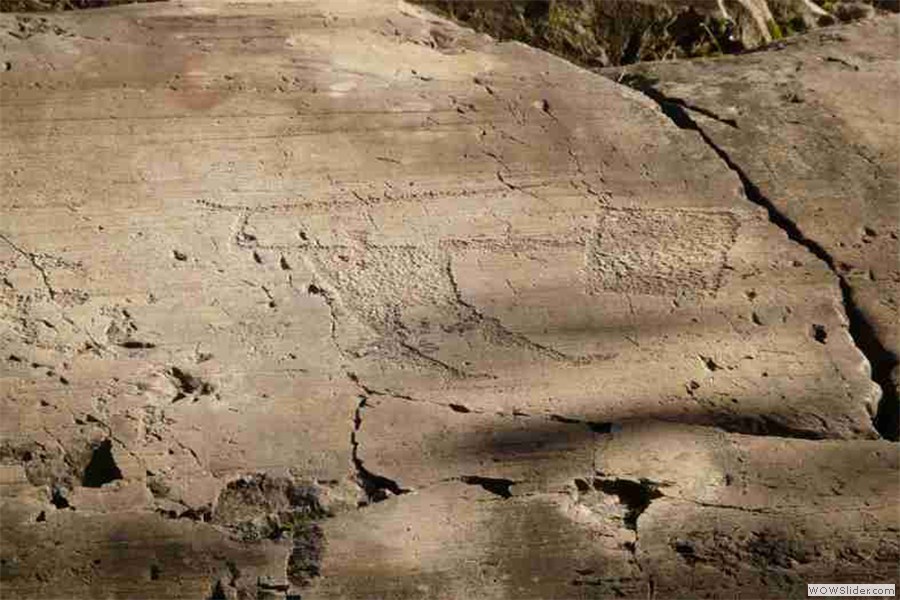
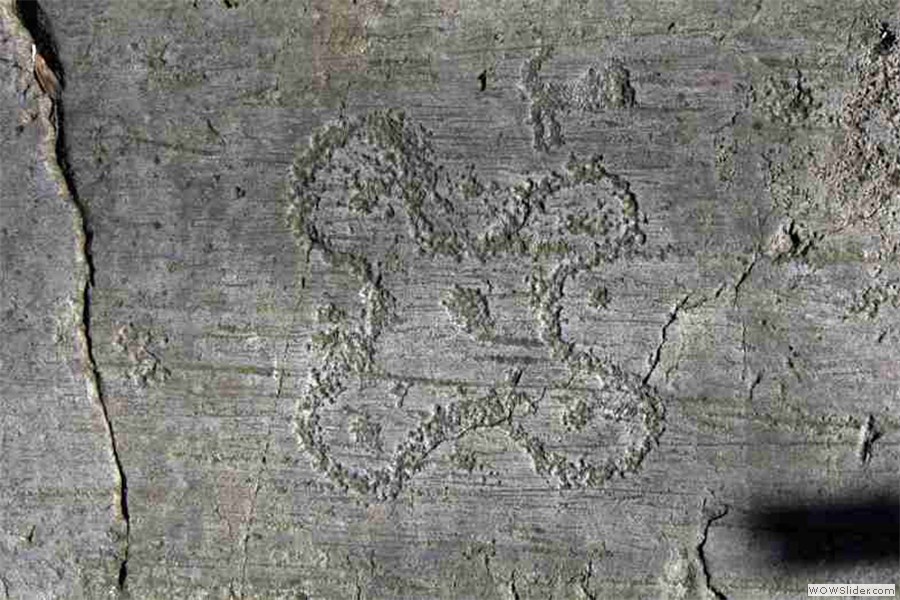
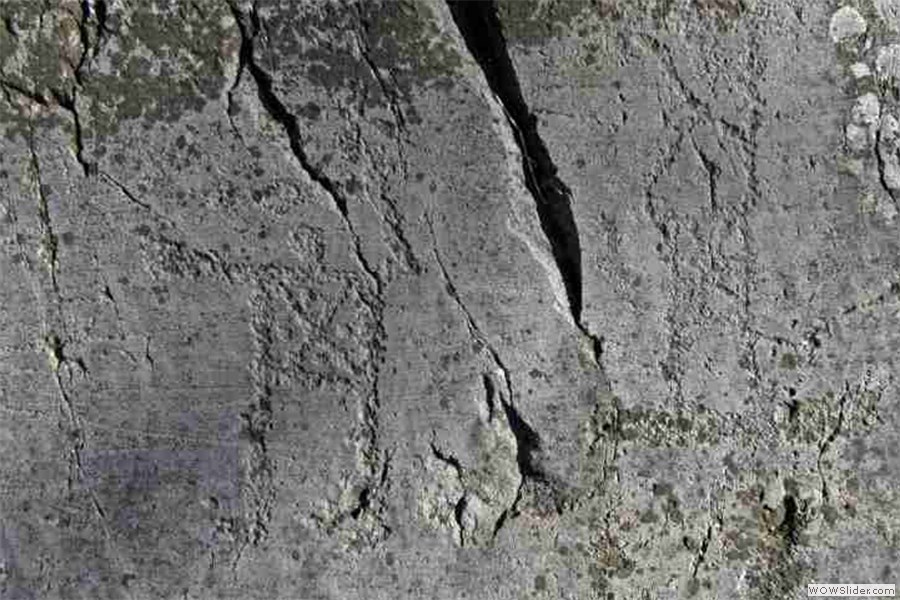
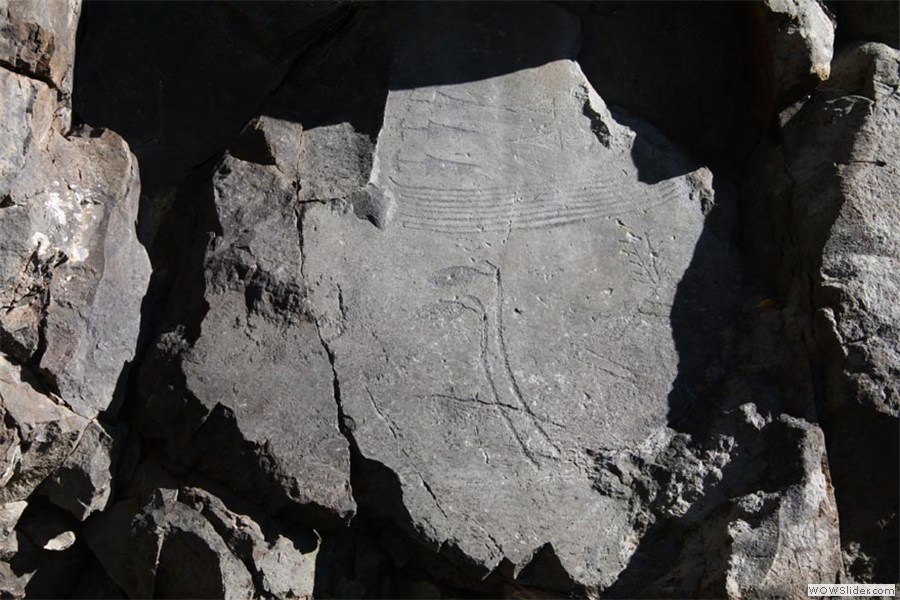 foto M.C.
foto M.C.




